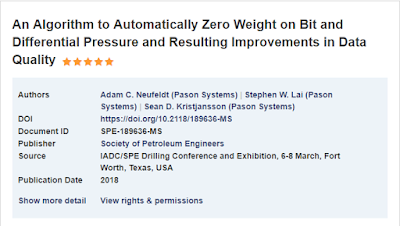 |
| Current level of Drilling Automation |
This week I am going to attempt to provide some answers to the question of “Why we aren’t further along with implementing Drilling Automation?”.
The thing that got me started thinking about this topic was an article in the Journal of Petroleum Technology discussing data accuracy, mainly a paper recently presented at the IADC/SPE Drilling Conference. The topic of that paper was An Algorithm to Automatically Zero Weight on Bit and DifferentialPressure and Resulting Improvements in Data Quality.
 |
| Abstract: SPE189636-MS |
The paper details a study by Pason, a company that collects, analyzes, and distributes real time and historical drilling data from rigs in North America. They conducted a study on the accuracy of Weight On Bit measurements and determined that the majority of the WOB data was incorrect due to drillers not properly zeroing the WOB indicator. They proceeded to develop an automated algorithm that zeroed the WOB and another key measurement, differential pressure. This improved the accuracy of the data collected immensely.
The thing in the JPT article that caught my eye was the question, paraphrased here, “What is keeping the industry, as a whole, from collecting more accurate data?” The main answer seems to be that collecting more accurate data is not free. Due to needing to utilize more accurate sensors and having, at minimum, personnel regularly recalibrate those sensors, to developing better sensors and systems, it all costs more money than the current standard provided.
This is a parallel to what we are seeing as a hindrance to progressing with Drilling Automation. Operators want the lowest price they can get to drill their wells, service & equipment providers want the highest price they can get for their equipment, products, & services, and in most cases, what you wind up getting is low-cost provider solution (read minimum quality for cheapest price).
In recent history, most operators have not wanted to help develop new technology and/or practices. While you do see companies like Statoil, Royal Dutch Shell, Apache, and others investing in drilling automation projects and sometimes partnering with service providers to do this, the majority do not.
I think part of the reason why we are not seeing large scale advancements with Drilling Automation is that there is not one entity in control of the entire operation. Factory automation is far easier for at least two reasons: Factories are usually controlled by a single entity and the tasks that are automated are simple, repeatable steps.
Drilling a well is not the same as operating a robotic factory. You can automate a lot of things that are repetitive and can be accomplished by robots. Drilling a well is not the case. There are exponentially more variables involved with drilling a well than welding pieces of a car together. Due to that expansive number of variables, changes in each multiply the contingencies and potential responses needed. To sum it up, it is not an easy task to accomplish. Not impossible, mind you, just not easy.
A lot of wells involve a minimum of three or four different companies working to drill the well. All with different goals and business models. That adds to the complexity. This can be somewhat caveated by Red or Blue rig models where a single service company provides most or all of the various services to the operator on the rig, OR the independent Operator model where they hire their own consultants and utilize third-party suppliers for equipment & products.
So, because of all this complexity, in addition to variations in the market (read: Current, hopefully over, crash in the industry), it makes it hard to make progress with drilling automation.
BUT, there are changes afoot! Industry conferences are starting to highlight Drilling Automation. More companies are becoming involved in the space. With the progress being seen in artificial intelligence, things that someone had to “feel” or “intuit” may soon be reduced to a routine validated by a computer algorithm.
We are starting to see progress. Interest from multiple players, large and small. Companies transferring their expertise from wetware to hardware and software. The singularity for Drilling Automation is not tomorrow. We may never get to a totally automated drilling process with no human involvement, but if we can get 95% there, that will be a huge reduction in cost and increase in efficiency!
And, as always, let me know what you think in the comments. Ask questions, tell your story.
If you like my posts, please share them with others and subscribe to this blog.
Discover more from The Clint Galliano
Subscribe to get the latest posts sent to your email.

